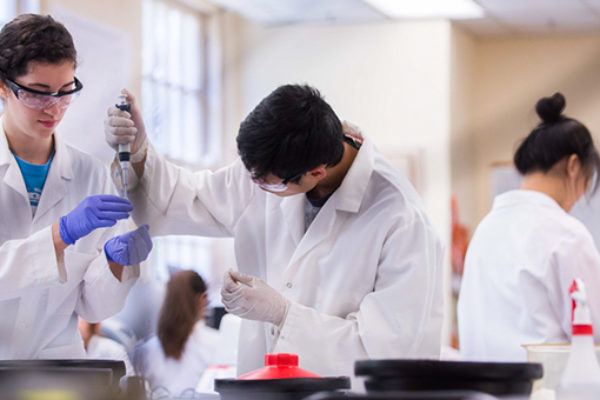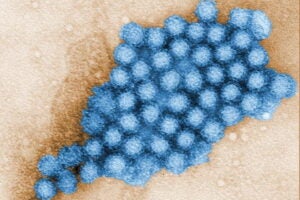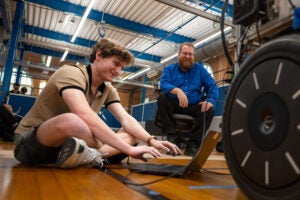AUSTIN, Texas — In a positive sign for efforts to boost U.S. competitiveness in science and technology, a new study finds that courses that engage college students in conducting scientific research early on can dramatically increase students’ odds of completing a science, technology, engineering or math (STEM) degree.
The study, published in today’s edition of CBE-Life Sciences Education, is the largest and most carefully controlled analysis to date of how participating in course-based undergraduate research experiences affects students’ outcomes. It found that across all demographic groups students who participated in a program called the Freshman Research Initiative were more likely to graduate college and to earn degrees in STEM disciplines at The University of Texas at Austin.
“We’ve been able to increase STEM retention by almost 25 percent,” says Erin Dolan, executive director of the Texas Institute for Discovery Education in Science at UT Austin and senior author on the new study. “This is a real solution for addressing the shortfall in the STEM workforce that we anticipate for the next decade.”
According to a 2012 report from the President’s Council of Advisors on Science and Technology, the U.S. needs to produce approximately 1 million more STEM professionals during the next decade than is currently projected, yet “fewer than 40 percent of students who enter college intending to major in a STEM field complete a STEM degree.” The report indicated that boosting retention of STEM majors to 50 percent nationwide would provide three-fourths of the needed increase in STEM workers, and it suggested that improving science education with more hands-on research opportunities would be a good strategy.
The decade-old Freshman Research Initiative (FRI) in UT Austin’s College of Natural Sciences puts first- and second-year undergraduate students in faculty-led labs, a model that is unconventional at research universities. The newly published research finds that FRI:
- Increases a student’s likelihood of graduating with an undergraduate degree from 66 to 83 percent, and
- Increases a graduate’s likelihood of earning a STEM degree from 71 to 94 percent.
This means that for every 10 students who enter the College of Natural Sciences and participate in FRI, two will graduate who were likely otherwise to drop out or take longer than six years to get an undergraduate degree, and three more will wind up with STEM degrees, as opposed to changing majors.
Early successes at UT Austin have led six universities, including three more in the UT System, to replicate the approach in which students work in teams to conduct research projects with guidance from established scientist mentors. Students at UT Austin choose projects from more than 25 different research areas in the life sciences, physical sciences and computer science. Projects have included developing diagnostic tools for the Zika virus, programming autonomous robots, attempting to develop biofuels, and identifying wine varieties based on their chemical makeup.
“Students who participate in FRI are more likely to graduate from college and are more likely to finish a STEM major,” Dolan says. “They go on to do exciting things like graduate school, medical school, work in industry and even start their own companies.”
Dolan and her colleagues analyzed data from more than 4,000 students who participated in the FRI program. They carefully matched these FRI students with peers who did not participate but were otherwise comparable in terms of socioeconomic background, gender, race, ethnicity, scores on standardized tests and other factors.
Students who are underrepresented minorities or first in their families to go to college are even more likely than their counterparts to leave STEM and leave college, earlier research has found. Dolan and the other authors found that FRI boosts retention and graduation for students regardless of their socioeconomic backgrounds or racial and ethnic backgrounds.
“Many science educators have suspected that early exposure of undergraduates to the process of doing real science would have educational benefits,” said Nobel laureate Carl Wieman, a Stanford University physics and education professor, who did not participate in the study but has been a champion for improving undergraduate science nationwide. “This study provides the first good evidence, with a large and diverse population of students, that such exposure through undergraduate research has dramatic benefits for all students, substantially improving both graduation rates in STEM and overall graduation rates. Every university ought to be looking closely at these results as they think about how to improve the quality of STEM education provided to their students.”
Dolan’s co-authors are Stacia Rodenbusch, director of the Freshman Research Initiative at UT Austin; Paul Hernandez, assistant professor in educational psychology at West Virginia University, Morgantown; and Sarah Simmons of the Howard Hughes Medical Institute, who was the founding director of the Freshman Research Initiative.
The research was supported by the National Science Foundation and the Howard Hughes Medical Institute.




